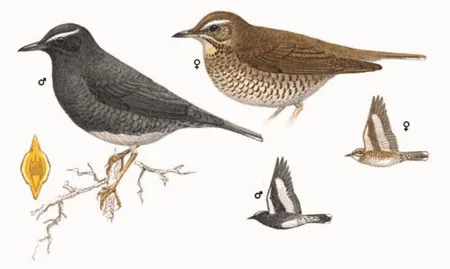
Siberian Thrush
[order] PASSERIFORMES | [family] Turdidae | [latin] Zoothera sibirica | [UK] Siberian Thrush | [FR] Grive de Siberie | [DE] Schieferdrossel | [ES] Zorzal de Siberia | [NL] Siberische Lijster
Subspecies
| Genus | Species | subspecies | Breeding Range | Breeding Range 2 | Non Breeding Range |
| Zoothera | sibirica | EU | e | Southeast Asia | |
| Zoothera | sibirica | davisoni | |||
| Zoothera | sibirica | sibirica |
Physical charateristics
Close in size to Song Thrush. Rather flat-crowned thrush; adult male mainly dark slate, female and immature buff-brown, mottled and barred below, but in all plumages identifiable by prominent white or pale supercilium and tail-corners, and black- and white-barred underwing.
Listen to the sound of Siberian Thrush
[audio:http://www.aviflevoland.nl/sounddb/S/Siberian Thrush.mp3]
Copyright remark: Most sounds derived from xeno-canto
| wingspan min.: | 34 | cm | wingspan max.: | 36 | cm |
| size min.: | 22 | cm | size max.: | 23 | cm |
| incubation min.: | 0 | days | incubation max.: | 0 | days |
| fledging min.: | 0 | days | fledging max.: | 0 | days |
| broods: | 0 | eggs min.: | 0 | ||
| eggs max.: | 0 |
Range
Eurasia : East
Habitat
Breeds in east Palearctic, from upper to lower middle latitudes, mainly in boreal coniferous taiga zone, largely lowland but partly montane. The sparse data suggest preference for dense stands of trees or shrubs, especially spruce and broad-leaved species such as poplars on moist ground in flood plains of rivers or in neighbourhood of water. In winter in India, frequents hill forest up to at least 1800 m.
Reproduction
The nest, is built in a bush at approximately 2 meters above the ground. The nest is composed of grass, leafs and mud. It contains The incubation, tended by male and female, is carried out at the end of June. The young fledge at the beginning of August.
Feeding habits
Omnivorous. It consumes a large variety of insects and invertebrates, in particular earth worms, but also bees. the Siberian thrush is forages on the ground, under dense leaf cover and is rather difficult to observe.
Conservation
This species has an extremely large range, and hence does not approach the thresholds for Vulnerable under the range size criterion (Extent of Occurrence <20,000 km2 combined with a declining or fluctuating range size, habitat extent/quality, or population size and a small number of locations or severe fragmentation). Despite the fact that the population trend appears to be decreasing, the decline is not believed to be sufficiently rapid to approach the thresholds for Vulnerable under the population trend criterion (>30% decline over ten years or three generations). The population size has not been quantified, but it is not believed to approach the thresholds for Vulnerable under the population size criterion (<10,000 mature individuals with a continuing decline estimated to be >10% in ten years or three generations, or with a specified population structure). For these reasons the species is evaluated as Least Concern.

Migration
Migratory. Siberian populations migrate south from breeding range in eastern Siberia (or south-west from east of range) across Mongolia and China, mainly east of 100 degrees E, to winter quarters in south-east Asia. Leave breeding grounds from early September but some birds still present until mid-October; arrive India from October. Northward migration from late March, arriving on breeding grounds from late May.
European records August-March (mainly October-February) include flocks of 17-18 birds in Poland in January and March and c. 25 birds in Hungary in mid-February.
European records August-March (mainly October-February) include flocks of 17-18 birds in Poland in January and March and c. 25 birds in Hungary in mid-February.
Distribution map

